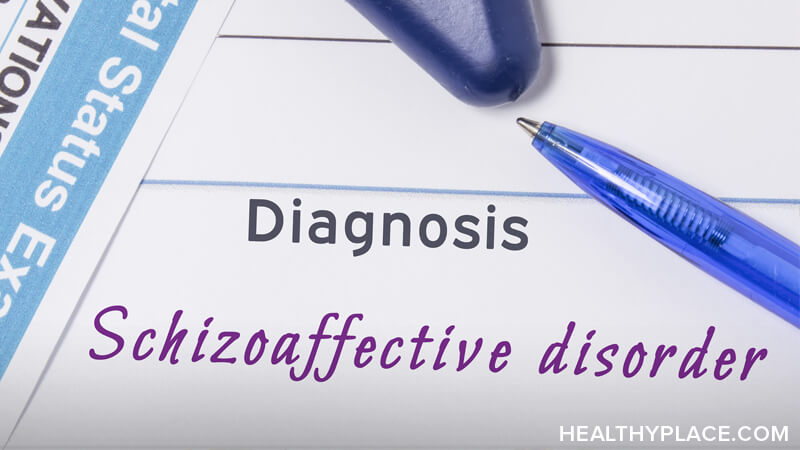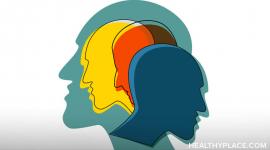Diagnosing Schizoaffective Disorder: DSM-5 Criteria

Schizoaffective disorder is, like schizophrenia, a psychotic disorder. In addition to psychotic features, schizoaffective disorder has significant mood symptoms. This rare mental illness is related to both schizophrenia and bipolar disorder or major depressive disorder and affects approximately one-third fewer people than schizophrenia.
To receive a schizoaffective disorder diagnosis, someone must meet all the primary criteria for schizophrenia and have prominent mood disorder symptoms as well. This basic description of this disorder is accurate, but it falls a bit short. Let’s take a deeper look to answer the question: What is schizoaffective disorder?
Schizoaffective Disorder DSM-5
The American Psychiatric Association explains schizoaffective disorder in the DSM-5, the book that is the accepted authority on mental illness and personality disorders. Someone with schizoaffective disorder meets the primary criteria (Criterion A) for schizophrenia, which includes two or more of the following:
- Delusions
- Hallucinations
- Disorganized speech (speech that is easily derailed or is incoherent)
- Grossly disorganized or catatonic behavior
- Negative symptoms (flat expressions, loss of pleasure/anhedonia, lack of motivation/avolition, and other experiences that are “taken away” from the person)
Schizoaffective disorder includes at least two of the above symptoms related to psychotic disorders and these DSM-5 criteria:
- A major mood episode (either major depression or mania) that lasts for an uninterrupted period of time
- Delusions or hallucinations for two or more consecutive weeks without mood symptoms sometime during the life of the illness
- Mood symptoms are present for the majority of the illness
- The symptoms aren’t caused by substance use
(More on schizoaffective disorder symptoms here.)
Schizoaffective Disorder: Psychotic Features, Mood Features
When someone is experiencing both psychotic and mood symptoms, it can be difficult to determine what he or she is truly experiencing. Schizophrenia, schizoaffective disorder, and bipolar disorder all can involve
- Feelings of elation for an extended period
- Rapid speech
- Racing thoughts
- Bizarre behavior
- Risk-taking behaviors
- Agitation
- Grandiose delusions
- Hallucinations
If someone is experiencing such a mix of symptoms, what’s going on? Is it a psychotic disorder with mood features, or is it a mood disorder with psychotic features? Both types of schizoaffective disorder diagnoses exist, and it often takes time for professionals and family members to help someone sort out what she’s experiencing.
Professionals gather evidence and look for patterns of symptoms and behaviors. If someone’s dominant symptoms are mood symptoms but he experiences some periods of psychotic features, he most likely has a mood disorder with psychotic features.
If, however, someone experiences both psychotic and mood symptoms but has at least one two-week period during which she only has psychotic symptoms—mood symptoms aren’t present—then the likelihood is that she has schizoaffective disorder.
The difference between schizoaffective disorder and a mood disorder such as bipolar disorder is subtle, but the DSM-5 delineates the criteria for each, thus helping doctors make the right diagnosis (and thus get the correct schizoaffective disorder treatment). What about the difference among the psychotic disorders? Is schizoaffective disorder the same as schizophrenia?
Schizoaffective Disorder vs. Schizophrenia
Both psychotic disorders share the same primary criteria, listed above as schizophrenia’s criterion A. Schizoaffective disorder involves the addition of mood symptoms. Here’s where it can become confusing: Many of the negative symptoms of schizophrenia, as well as the disorganized behavior and speech, resemble mood-related symptoms.
Could schizophrenia and schizoaffective disorder really be the same diagnosis with a slightly different manifestation in each person? The official answer is no, they are not the same diagnosis.
The DSM-5 includes each of these disorders and gives them their own place within the same section. Several characteristics highlight why each disorder is unique and stands on its own. These features point to schizoaffective disorder:
- Mood symptoms are present for most of the illness
- Social dysfunction isn’t as pronounced as it is in schizophrenia
- Negative symptoms such as the inability to perform self-care aren’t as severe as they are in schizophrenia
- It’s possible to have autism spectrum disorder or another developmental disorder starting in childhood (schizophrenia isn’t diagnosed if such disorders are present, but schizoaffective disorder can be)
Schizoaffective disorder is a psychotic disorder with significant mood features. Like any other mental illness, schizoaffective disorder is highly individualized, so while the standard criteria must be met for a diagnosis, each person manifests those criteria differently.
The prognosis for those living with schizoaffective disorder is mixed. Some people living with schizoaffective disorder function fairly well, while others have symptoms that are more severe and life-limiting. Each person with this disorder has both psychotic and mood symptoms, but everyone has them in different proportions.
Diagnosing schizoaffective disorder can be challenging, but it’s not impossible thanks to the criteria established in the DSM-5. The more accurate someone’s diagnosis, the more specific the treatment plan will be. The right diagnosis means that schizoaffective disorder can be better managed, giving someone a better quality of life.
APA Reference
Peterson, T.
(2021, December 23). Diagnosing Schizoaffective Disorder: DSM-5 Criteria, HealthyPlace. Retrieved
on 2025, April 15 from https://www.healthyplace.com/thought-disorders/schizoaffective-disorder-information/what-is-schizoaffective-disorder-dsm-5-criteria



